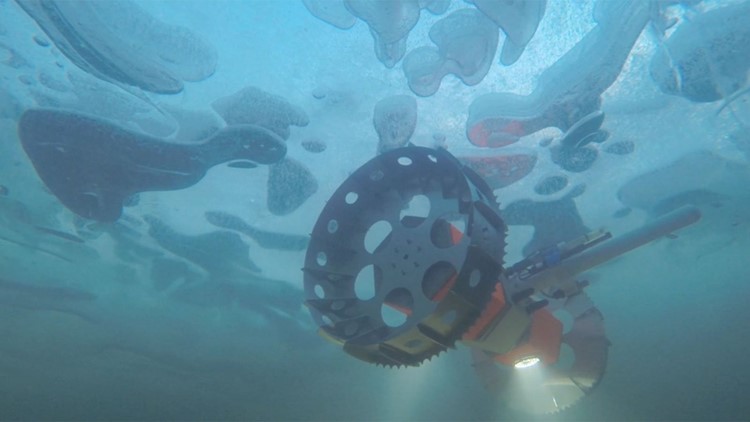Astronomers have uncovered increasing evidence that some bodies in our solar system, like Jupiter’s moon Europa and Saturn’s moon Enceladus, are actually ocean worlds.
And those oceans could potentially host life — even if they formed in a way that is completely different from what we know about similar bodies of water on Earth.
To learn more, astronomers want to get up close and observe these worlds with robots, much like the way rovers have been used to explore the surface of Mars. But for that to happen, the robot would need to be equipped to handle the unknowns of an icy cold alien ocean.
A team at NASA’s Jet Propulsion Laboratory is working on the Buoyant Rover for Under-Ice Exploration just for that purpose. Called BRUIE, the rover is about to face the ultimate test by operating upside down beneath sea ice in Antarctica for a month, according to NASA.
Antarctica is a good analog for what rovers like BRUIE may one day face on ocean worlds, because Europa and Enceladus’ oceans are encased beneath icy shells anywhere between six to 12 miles thick. Previously, BRUIE was tested in the Arctic and Alaska.
In 2017, NASA announced that these ocean worlds may be the best hubs for life in our solar system. “Once we get there we only really know how to detect life similar to that on Earth. So it’s possible that very different microbes might be difficult to recognize,” said Dan Berisford, BRUIE mechanical engineer.
“The ice shells covering these distant oceans serve as a window into the oceans below, and the chemistry of the ice could help feed life within those oceans. Here on Earth, the ice covering our polar oceans serves a similar role, and our team is particularly interested in what is happening where the water meets the ice,” said Kevin Hand, lead scientist for the BRUIE project.
A rover exploring an ocean world will need to navigate on its own. BRUIE is about three feet long and has two wheels to help it roll upside down along the ice. Images and data collected by the floating rover will allow scientists to study the “ice-water interface.”
“We’ve found that life often lives at interfaces, both the sea bottom and the ice-water interface at the top. Most submersibles have a challenging time investigating this area as ocean currents might cause them to crash, or they would waste too much power maintaining position,” said Andy Klesh, lead engineer. “BRUIE, however, uses buoyancy to remain anchored against the ice and is impervious to most currents. In addition, it can safely power down, turning on only when it needs to take a measurement, so that it can spend months observing the under-ice environment.”
During the Antarctic tests, the team will test the instruments on the rover. This include two cameras with live capabilities.
“BRUIE will carry several science instruments to measure parameters related to life, such as dissolved oxygen, water salinity, pressure and temperature,” said Berisford.
A crew will drill holes in the ice to station BRUIE in the water and make sure it’s tethered to the surface. They anticipate that the rover may encounter penguins and seals who are curious about the little robot rover doing an upside-down underwater expedition.
The team ultimately wants BRUIE to be able to withstand conditions beneath the ice for months on end, explore without the safety of a tether and investigate oceans at deeper levels.
In August, NASA announced that its upcoming Europa Clipper mission, which will send a spacecraft and scientific instruments to Jupiter’s frigid moon Europa, is entering its final design stage before beginning construction and testing.
Europa has been a high priority for scientists because, as an ice-covered moon with a subsurface salty liquid ocean, it has been identified as one of the ideal spots for hosting life in our solar system.
The Europa Clipper, named for the streamlined sailing ships of the 1800s, could launch as early as 2023, but a targeted launch has been set for 2025. It is expected to reach Europa after a journey lasting several years.
Europa Clipper will carry cameras and spectrometers to capture images and determine the composition of the moon. Ice-penetrating radar will measure the thickness of the ice shell covering the ocean and help search for the subsurface lakes believed to be there, much like those in Antarctica on Earth. A magnetometer can determine the strength and direction of the moon’s magnetic field to understand how deep the ocean goes and its salinity.



